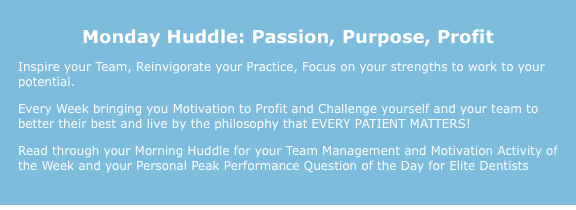Here we are my friends – back again with the real deal, the main point, the only thing that matters. In order to help patients get healthy we have to get them to say yes by believing in their health, your solutions and your relationship so much so that they will actually pay you money for what you do.
The most important truth about patients who do not accept treatment is the fact that we just let them off the hook. That’s it. They say no and then we’re done. Team members and doctors alike make it way too easy to say no and walk away, to say no and delay, to say no and never come back.
You really have to own the idea that it’s infinitely easier to get the patient to say yes while they are still in the office in front of you. And it’s much easier to keep a conversation going and to talk through things than to try to get them back on the phone or back in the office another time.
This should be empowering to you to know that no patient would really want to stay unhealthy, at risk of disease, face future failure or any other bad circumstance. No one would want that.
So why don’t more say yes to more treatment?
It comes down to four key points…
1. Patients think they can wait it out because you haven’t made it important enough
2. Patients don’t believe you (which is a real problem)
3. Patients don’t value the benefits or outcome that you are telling them about
4. Patients do not feel the money is worth it because of all three of the first points
Pretty much that is it. If it’s not important, if it’s not believed, if it’s not worth it then of course I’m going to say no to giving you money because I’d rather have the money then have the treatment.
If you study everything my team and I provide you (and you really take the structure and psychology of the patient engagement seriously), then you will never run into these issues.
You have to ask yourself: are you doing enough to overcome these situations in the patients’ minds BEFORE they bring them up themselves? Realize that patients will never bring up anything specific they will just say…
“I have to think about it”
“I’m going to talk with my spouse”
“I can’t afford it”
“Not right now”
“Maybe next time”
Overcoming these is about being proactive and having an experience that builds so much support and preponderance of proof that they can’t use these excuses.
If they do, then you must be ready with the following strategies that will always overcome every major objection (especially any of these)…
1st This can be used ideally before you ever get an objection but also if you do have a patient try to rebuttal treatment…
You tell them why it is important and what you would like to see them accomplish. You want to give them a goal or a target as a baseline of why this matters.
Something like, “Well, Mrs. Jones we think every patient should have a goal to have all of their teeth to prevent bone loss and to be able to chew and eat properly…”
2nd It must be a reflex to never be passive when a patient says no. Keep right on talking and go through the reasons why it’s importance. If they persist, then you will move to point number three and the third strategy.
I can’t exaggerate enough how much more yeses you will get just by NOT accepting the first no.
3rd You want to practice having a list of challenge questions that you can ask the patient when they try to object.
You say, “I’m curious Mrs. Jones, what did you think the investment would be?”
“I just want to understand your goals better, why is it you would not want to move forward with improving your health in this way?”
“When I hear you say that Mrs. Jones, I feel like I must not have done a good job relaying the importance of this and why you really deserve this to happen. Which area could I have explained better?”
The list goes on and on and you can come up with some really powerful questions as a team and go to work on this.
Everything I’m telling you can be used in the clinical room when building the treatment plan, when diagnosing and getting the clinical yes, when presenting treatment, and going for the close with money and schedule.
More on this next week…
For now, practice with your team and make your lists. Work on keeping your patients in the practice and talking through everything before they leave. This is how you will get more yeses and more treatment!



